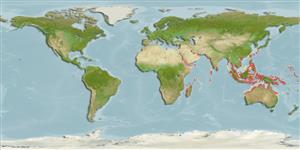Environment: milieu / climate zone / depth range / distribution range
Ecología
marino; agua dulce; salobre demersal; anfidromo (Ref. 51243); rango de profundidad 0 - 4 m (Ref. 90102). Tropical
Distribución
Países | Áreas FAO | Ecosistemas | Ocurrencias, apariciones | Point map | Introducciones | Faunafri
Indo-West Pacific: western India to the Mekong.
Tamaño / Peso / Age
Maturity: Lm ? range ? - ? cm
Max length : 10.0 cm SL macho / no sexado; (Ref. 12693)
Espinas dorsales (total): 6 - 7; Radios blandos dorsales (total): 10; Espinas anales 1; Radios blandos anales: 8 - 9. Characterized by pale grey body color with irregular brown blotches on cheek, without pronounced dark patch covering top of head; presence of four dark brown saddles (including one on nape) dorsally on side; caudal fin base with diffuse blackish bar; presence of dark wedge-shaped mark on pectoral fin base; fully united pelvic fins, frenum present; rounded caudal fin; longitudinal scale series 36-44; presence of barbels on snout, tip of chin, and ventrally below lower jaw (except none on posterior mandible); strongly ctenoid scales; cheek and opercle without scales; deeply embedded nape scales; presence of sensory pores on head, including two preopercular pores; depth of body about 5.9 in SL (Ref. 90102).
Inhabits mud and rock bottoms near shore in 0-4 m (Ref. 90102). Found in coastal waters, estuaries (Ref. 4833), tidal rivers, canals and creeks (Ref. 12693). Feeds on small fishes, crustaceans and insects. Not seen in markets (Ref. 12693).
Life cycle and mating behavior
Madurez | Reproducción | Puesta | Huevos | Fecundidad | Larva
Talwar, P.K. and A.G. Jhingran, 1991. Inland fishes of India and adjacent countries. Volume 2. A.A. Balkema, Rotterdam, i-xxii + 543-1158, 1 pl. (Ref. 4833)
IUCN Red List Status (Ref. 130435)
Threat to humans
Harmless
Human uses
Warning: mysqli::__construct(): (HY000/1040): Too many connections in /var/www/html/includes/func_getlabel.php on line 46
Can't connect to MySQL database (fbapp). Errorcode: Too many connections
